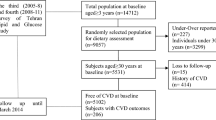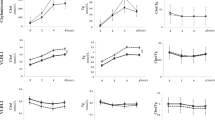Abstract
Objective:
The aim of the study is to evaluate the effect of moderate Sicilian red wine consumption on cardiovascular risk factors and, in particular, on some inflammatory biomarkers.
Methods:
A total of 48 subjects of both sexes who were nondrinkers or rare drinkers of moderate red wine were selected and randomly subdivided into two groups assigned to receive with a crossover design a Sicilian red wine (Nero d'Avola or Etna Torrepalino) during meals: Group A (n=24), in whom the diet was supplemented for 4 weeks with 250 ml/day of red wine, followed by 4 weeks when they returned to their usual wine intake; and Group B (n=24), in whom the usual wine intake was maintained for 4 weeks, followed by 4 weeks when the diet was supplemented with 250 ml/day of red wine. The following were values measured in all tests: blood glucose, total and HDL-cholesterol and triglycerides, LDL-cholesterol, LDL/HDL ratio, apolipoproteins A1 and B, Lp(a), plasma C-reactive protein, TGFβ1, D-Dimer, Factor VII , PAI Ag, t-PA Ag, fibrinogen, oxidized LDL Ab, total plasma antioxidant capacity.
Results:
At the end of the red wine intake period, LDL/HDL, fibrinogen, factor VII, plasma C-reactive protein and oxidized LDL Ab were significantly decreased, while HDL-C, Apo A1,TGFβ1, t-PA, PAI and total plasma antioxidant capacity were significantly increased.
Conclusions:
Our results show a positive effect of two Sicilian red wines on many risk factors and on some inflammatory biomarkers, suggesting that a moderate consumption of red wine in the adult population is a positive component of the Mediterranean diet.
This is a preview of subscription content, access via your institution
Access options
Subscribe to this journal
Receive 12 print issues and online access
$259.00 per year
only $21.58 per issue
Buy this article
- Purchase on Springer Link
- Instant access to full article PDF
Prices may be subject to local taxes which are calculated during checkout
Similar content being viewed by others

References
Albert CM, Manson JE, Cook NR, Ajani UA, Gaziano JM, Hennekens CH (1999). Moderate alcohol consumption and the risk of sudden cardiac death among US male physicians. Circulation 100 (9), 944–950.
Artaud-Wild SM, Connor SL, Sexton G, Connor WE (1993). Differences in coronary mortality can be explained by differences in cholesterol and saturated fat intakes in 40 countries but not in France and Finland. Circulation 88, 2771–2779.
Assmann G, Cullen P, Schulte H (1998). The Munster Heart Study (PROCAM): results of follow-up at 8 years. Eur Heart J 19 (Suppl. A), A2–11.
Avellone G, Di Garbo V, Abruzzese G, Bono M, Avellone G, Raneli G et al. (2003). Cross-over study on effects of Mediterranean diet in two randomly selected population samples. Nutr Res 23 (10), 1329–1339.
Avellone G, Di Garbo V, Campisi D, Alonzo G, Gambino L, Avellone G et al. (2004). Effetto di due vini rossi siciliani su alcuni fattori di rischio cardiovascolare. Italian Heart J 5, 382–388.
Badia E, Sacanella E, Fernandez-Sola J, Nicolas JM, Antunez E, Rotilio D et al. (2004). Decreased tumor necrosis factor-induced adhesion of human monocytes to endothelial cells after moderate alcohol consumption. Am J Clin Nutr 80 (1), 225–230.
Benzie IFF, Strain JJ (1996). The ferric reducing ability of plasma (FRAP) as a measure of ‘antioxidant power’: the FRAp assay. Anal Biochem 239, 70–76.
Carluccio MA, Siculella L, Ancora MA, Massaro M, Scoditti E, Storelli C et al. (2003). Olive oil and red wine antioxidant polyphenols inhibit endothelial activation. Antiatherogenic properties of Mediterranean diet phytochemicals. ThrombVasc Biol 23, 622.
Cartron E, Fouret G, Carbonneau MA, Laret C, Michel F, Monnier Descomps B et al. (2003). Red-wine beneficial long-term effect on lipids but not on antioxidant characteristics in plasma in a study comparing the type of wine – description of two O-methylated derivatives of gallic acid in humans. Free Rad Res 37 (9), 1021–1035.
De Lange DW, Van Golden PH, Scholman WL, Kraaijenhagen RJ, Akkerman JW, Van De Wiel A (2003). Red wine and red wine polyphenolic coumpounds but not alcohol inhibit ADP-induced platelet aggregation. Eur J Intern Med 14 (6), 361–366.
de Lorgeril M, Salen P, Paillard F, Laporte F, Boucher F, de Leiris J (2002). Mediterranean diet and the French paradox: two distinct biogeographic concepts for one consalidated scientific theory on the role of nutrition in coronary heart disease. Cardiovasc Res 54, 503–515.
De Oliveira e Silva ER, Foster D, McGee Harper M, Seidman CE, Smith JD, Breslow JL et al. (2000). Alcohol consumption raises HDL cholesterol levels by increasing the transport rate of apolipoproteins AI and AII. Circulation 102 (19), 2347–2352.
Di Bari M, Zacchei S, Kritchevsky SB, Anichini M, Cesaretti S, Chia Mn Massotti G et al. (2003). Anti-oxidized LDL antibodies and wine consumption: a population-base epidemiological study in Dicomano, Italy. Ann Epidemiol 13 (3), 189–195.
Di Garbo V, Bono M, Di Raimondo D, De Simone R, Raneli G, Avellone G (2000). Non lipid, dose-dependent effects of pravastatin treatment on hemostatic system and inflammatory response. Eur J Clin Pharmacol 56, 277–284.
Estruch R, Sacanella E, Badia E, Antunez E, Nicolas JM, Fernandez-Sola J et al. (2004). Different effects of red wine and gin consumption on inflammatory biomarkers of atherosclerosis: a prospective randomized crossover trial. Effects of wine on inflammatory markers. Atherosclerosis 175 (1), 117–123.
Frankel EN, Kanner J, German JB, Parks E, Kinsella JE (1993a). Inhibition of oxidation of human low-density lipoprotein by phenolic substances in red wine. Lancet 341, 454–457.
Frankel EN, Waterhouse AL, Kinsella JE (1993b). Inhibition of human LDL oxidation by resveratrol. Lancet 341, 1103–1104.
Gaziano JM, Hennekens CH, Godfried SL, Sesso HD, Glynn RJ, Breslow JL et al. (1999). Type of alcoholic beverage and risk of myocardial infarction. Am J Cardiol 83 (1), 52–57.
Gebbia N, Bavaresco L, Fregoni M, Colditz GA, Ascherio A, Rosner B, Stampfer MJ (2003). Contenuto di un nuovo stilbene (piceatannolo) in alcuni vini della Sicilia. Vignevini 30 (5), 87–94.
Goldfinger M (2003). Beyond the French paradox: the impact of moderate beverage alcohol and wine consumption in the prevention of cardiovascular disease. Cardiol Clin 21 (3), 449–457.
Hertog MGL, Feskens EJM, Hollman PCH, Katan MB, Kromhout D (1993). Dietary antioxidant flavonoids and risk of coronary heart disease: the Zutphen Elderly Study. Lancet 342, 1007–1011.
Imfof A, Froehlich M, Brenner H, Boeing H, Pepys MB, Koenig W (2001). Effect of alcohol consumption on systemic markers of inflammation. Lancet 357 (9258), 763–767.
Kondo K, Matsumoto A, Kurata H, Tanahashi H, Koda H, Amachi T et al. (1994). Inhibition of oxidation of low-density lipoprotein with red wine (letter). Lancet 344, 1152.
Lacko AG, Barter P, Ehnholm C, van Tol A (2000). International symposium on basic aspects of HDL, metabolism and disease prevention. J Lipid Res 41 (10), 1695–1699.
Meade TW, Mellow S, Brozovic M, Miller GJ, Chakrabarti RR, North WRS et al. (1986). Haemostatic function and ischaemic heart disease: Principal results of the Northwich Peak heart study. Lancet 328, 533–537.
Mennen LI, Balkau B, Vol S, Caces E, Eschwege E (1999). Fibrinogen: a possible link between alcohol consumption and cardiovascular disease? DESIR Study Group. Arterioscler Thromb Vasc Biol 19 (4), 887–892.
Mezzano D, Leighton F, Martinez C, Marshall G, Cuevas A, Castillo O et al. (2001). Complementary effects of Mediterranean diet and moderate red wine intake on haemostatic cardiovascular risk factors. Eur J Clin Nutr 55 (6), 444–451.
Muntwyler J, Hennekens CH, Buring JE, Gaziano JM (1998). Mortality and light to moderate alcohol consumption after myocardial infarction. Lancet 352 (9144), 1882–1885.
Numminen H, Syrjala M, Benthin G, Kaste M, Hillbom M (2000). The effect of acute ingestion of a large dose of alcohol of the hemostatic system and its circadian variation. Stroke 31 (6), 1269–1273.
Pace-Asciak CR, Hahn S, Diamandis EP, Soleas G, Goldberg DM (1995). The red wine phenolic trans-resveratrol and quercetin block human platelet aggregation and eicosanoid syntesis: implication for protection against coronary heart disease. Clin Chim Acta 235, 207–219.
Pignatelli P, Lenti L, Pulcinelli FM, Catasca R, Saccani G, Germano G et al. (2002). Red and white wine differently affect collagen-induced platelet aggregation. Pathophysiol Haemost Thromb 32, 56–58.
Renaud S, de Lorgeril M (1994). Wine, alcohol, platelets, and the French paradox for coronary heart disease. Lancet 339, 1523–1525.
Ridker PM, Vaughan DE, Stampfer MJ, Glynn RJ, Hennekens CH (1994). Association of moderate alcohol consumption and plasma concentration of endogenous tissue-type plasminogen activator. JAMA 272 (12), 929–933.
Rimm EB, Giovannucci EL, Willett WC, Colditz GA, Ascherio A, Rosner B et al. (1991). Prospective study of alcohol consumption and risk of coronary disease in men. Lancet 338, 464–468.
Sacco RL, Elkind M, Boden-Albala B, Lin IF, Kargman DE, Hauser WA et al. (1999). The protective effects of moderate alcohol consumption on ischemic stroke. JAMA 281 (1), 53–60.
Sierksma A, Van der Gaag MS, Kluft C, Hendriks HF (2002). Moderate alcohol consumption reduces plasma C-reactive protein and fibrinogen levels: a randomized, diet-controlled intervention study. Eur J Clin Nutr 56 (11), 1130–1136.
Stefoni S, Ciancioli G, Donati G, Dormi A, Silvestri MG, Coli L et al. (2002). Low TGF-beta1 serum levels are a risk factor for atherosclerosis disease in ESRD patients. Kidney Int 61 (1), 324–335.
Stoclet JC, Chataigneau T, Ndiaye M, Oak MH, E Bedoui J, Chata M et al. (2004). Vascular protection by dietary polyphenols. Eur J Pharmacol 500 (1-3), 299–313.
Tashiro H, Shimokawa H, Sadamatu K, Yamamoto K (2002). Prognostic significance of plasma concentrations of transforming growth factor-beta in patients with coronary artery disease. Coronary Artery Dis 13 (3), 139–143.
Acknowledgements
This study was supported by Sicilian Agricultural Development Bureau, Palermo: Targeted Project ‘Effetto dei vini rossi siciliani nella prevenzione delle cardiovasculopatie’.
Author information
Authors and Affiliations
Corresponding author
Additional information
Guarantor: G Avellone.
Contributors: The study was designed by GA and VDG. RDS and GR were responsible for the laboratory measurements and VDG carried out the data analysis. All authors contributed to the final version of the manuscript.
Rights and permissions
About this article
Cite this article
Avellone, G., Di Garbo, V., Campisi, D. et al. Effects of moderate Sicilian red wine consumption on inflammatory biomarkers of atherosclerosis. Eur J Clin Nutr 60, 41–47 (2006). https://doi.org/10.1038/sj.ejcn.1602265
Received:
Revised:
Accepted:
Published:
Issue Date:
DOI: https://doi.org/10.1038/sj.ejcn.1602265
Keywords
This article is cited by
-
Adapted dietary inflammatory index and differentiated thyroid carcinoma risk in two French population-based case–control studies
European Journal of Nutrition (2022)
-
The effect of grape products containing polyphenols on oxidative stress: a systematic review and meta-analysis of randomized clinical trials
Nutrition Journal (2021)
-
Genetic and nutritional factors determining circulating levels of lipoprotein(a): results of the “Montignoso Study”
Internal and Emergency Medicine (2020)
-
Inflammatory potential of diet and risk of lymphoma in the European Prospective Investigation into Cancer and Nutrition
European Journal of Nutrition (2020)
-
Potential health benefits of phenolic compounds in grape processing by-products
Food Science and Biotechnology (2019)


